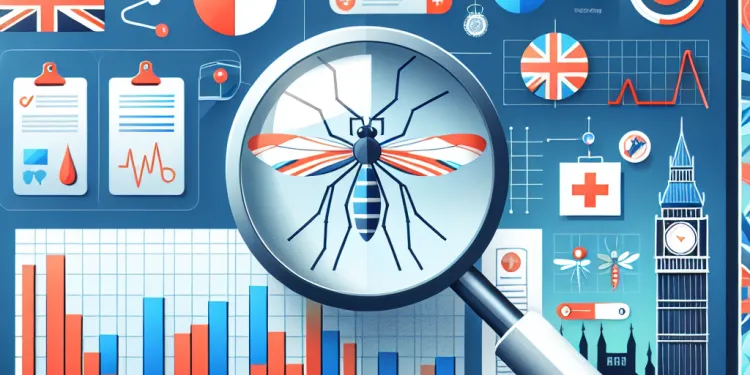
Find Help
More Items From Ergsy search
-

Has Marburg virus caused any major outbreaks?
Relevance: 100%
-

Are there any countries at higher risk for Marburg virus outbreaks?
Relevance: 77%
-

How do health authorities confirm a Marburg virus outbreak?
Relevance: 76%
-

What measures are being taken to control Marburg virus outbreaks?
Relevance: 75%
-

What is the Marburg Virus?
Relevance: 75%
-

Is the Marburg virus related to the Ebola virus?
Relevance: 70%
-

Is there a vaccine for Marburg virus?
Relevance: 69%
-

Where was the Marburg virus first discovered?
Relevance: 68%
-

What research is being done on the Marburg virus?
Relevance: 66%
-

How is the Marburg virus transmitted?
Relevance: 66%
-

What is the mortality rate of Marburg virus disease?
Relevance: 64%
-

Can Marburg virus disease be prevented?
Relevance: 61%
-

How is Marburg virus disease diagnosed?
Relevance: 61%
-

What is the typical progression of Marburg virus disease?
Relevance: 60%
-

How long is the incubation period for the Marburg virus?
Relevance: 60%
-

Can Marburg virus disease recur after recovery?
Relevance: 58%
-

How can healthcare workers protect themselves from Marburg virus infection?
Relevance: 57%
-

What are the symptoms of Marburg virus disease?
Relevance: 57%
-

Can Nipah Virus cause outbreaks?
Relevance: 48%
-

How is Nipah Virus controlled during outbreaks?
Relevance: 45%
-

What regions are most at risk for Nipah Virus outbreaks?
Relevance: 44%
-

Why are Nipah Virus outbreaks considered a public health concern?
Relevance: 42%
-

What is the Ebola virus?
Relevance: 38%
-

Are there any Zika virus outbreaks currently?
Relevance: 38%
-

Why are measles outbreaks still occurring?
Relevance: 35%
-

Is Zika virus present in the UK?
Relevance: 34%
-

What is Nipah Virus?
Relevance: 34%
-

Are measles outbreaks common in the UK?
Relevance: 34%
-

What triggers a cold sore outbreak?
Relevance: 34%
-

Is there a cure for Nipah Virus?
Relevance: 33%
-

Where was Nipah Virus first identified?
Relevance: 33%
-

What global organizations are involved in Nipah Virus research?
Relevance: 33%
-

Where do Chikungunya outbreaks typically occur?
Relevance: 32%
-

Is Zika virus screened for in blood transfusions?
Relevance: 32%
-

What is the mortality rate of Nipah Virus infection?
Relevance: 32%
-

Which animals are known to carry Nipah Virus?
Relevance: 30%
-

Is there a vaccine for the Zika virus?
Relevance: 29%
-

Should UK travelers be concerned about Zika virus?
Relevance: 29%
-

How do health officials monitor West Nile Virus?
Relevance: 29%
-

What should you do during a measles outbreak?
Relevance: 29%
Introduction to Marburg Virus
The Marburg virus is a highly infectious pathogen that belongs to the same family as the Ebola virus, the Filoviridae family. It causes Marburg virus disease (MVD), a severe form of hemorrhagic fever in humans and non-human primates. First documented in 1967, Marburg virus is named after the city of Marburg in Germany, where it was initially identified.
Major Outbreaks of Marburg Virus
Marburg virus has been responsible for several outbreaks, primarily in Africa. These outbreaks have varied in size and impact, and while not as numerous or well-known as Ebola outbreaks, they have nonetheless been significant in terms of public health impact and mortality.
1967: The Initial Outbreaks
The first recognized outbreaks occurred in 1967 in Marburg and Frankfurt in Germany, and in Belgrade, Yugoslavia (now Serbia). Laboratory workers who had been exposed to infected African green monkeys from Uganda fell ill. There were 31 cases and 7 deaths, resulting in a case fatality rate of over 22%.
1998-2000: Democratic Republic of Congo
A notable outbreak took place from 1998 to 2000 in the Durba and Watsa regions of the Democratic Republic of Congo. This outbreak resulted in 154 reported cases, out of which 128 people died, indicating a fatality rate of approximately 83%. The outbreak was linked to individuals working in gold mines, a setting where the Marburg virus is believed to thrive among bat populations that inhabited the caves.
2005: Angola Outbreak
The most severe and deadliest outbreak occurred in Angola between 2004 and 2005. Originating in Uige Province, it resulted in 252 cases with 227 deaths, marking an astonishing 90% fatality rate. This outbreak prompted a significant international response to contain the virus and minimize further spread.
Recent Outbreaks and Ongoing Concerns
More recent outbreaks have occurred in Uganda, with instances reported in 2007, 2012, and again in 2014. These outbreaks were much smaller in scale, with fewer deaths, owing in part to improved detection and response efforts. Nonetheless, Marburg virus continues to pose a threat due to its high mortality rate and potential for outbreak in areas with poor healthcare infrastructure.
Conclusion
Although Marburg virus is less widespread than other viral hemorrhagic fevers, its capacity to cause rapid fatal outbreaks makes it a pathogen of significant concern to global health authorities. Continued surveillance, research, and timely healthcare responses are critical in preventing future epidemics. The World Health Organization and other bodies continue to monitor the virus, aiming to mitigate its impact through enhanced readiness and awareness.
What is the Marburg Virus?
The Marburg virus is a very serious bug. It can make people and some animals very sick. It is like the Ebola virus. The virus can give you a very bad fever called Marburg virus disease (MVD). This was first found in 1967 in a place called Marburg in Germany. That's why it's called the Marburg virus.
Big Outbreaks of Marburg Virus
The Marburg virus has caused big health problems mainly in Africa. These health problems are called outbreaks. While outbreaks of the Marburg virus are not as well known as Ebola, they are serious and many people have died from them.
First Outbreaks in 1967
The first time the Marburg virus made people sick was in 1967. This happened in Germany in cities called Marburg and Frankfurt, and in a place called Belgrade, which is now in Serbia. People working in a lab got sick. They had been near sick monkeys from Africa. Thirty-one people got the disease and 7 died. This means about 22% of the sick people died.
Outbreak in Congo from 1998 to 2000
From 1998 to 2000, many people got sick in Congo, in places called Durba and Watsa. There were 154 people who got the disease and 128 of them died. This means lots of people died, about 83%. People working in gold mines got sick because the virus was in bats living in caves nearby.
Angola Outbreak in 2005
The worst outbreak was in Angola from 2004 to 2005. It started in a place called Uige Province. There were 252 cases and 227 people died. This means 90% of the people who got sick died. Many countries worked hard to stop the virus from spreading.
Recent Outbreaks and Concerns
Some smaller outbreaks happened in Uganda in 2007, 2012, and in 2014. There were not as many deaths in these outbreaks because health workers did a better job of finding and stopping the virus quickly. But the Marburg virus is still very dangerous, especially where healthcare is not very good.
Summary
The Marburg virus is not as common as other bad bugs, but it is very dangerous. It can make many people sick very quickly. Health experts are watching it closely to stop it from causing big problems. Groups like the World Health Organization work hard to keep us safe from the virus by watching, studying, and preparing for it.
Frequently Asked Questions
What is the Marburg virus?
The Marburg virus is a highly virulent pathogen that causes severe hemorrhagic fever in humans and non-human primates. It is part of the Filoviridae family, which also includes the Ebola virus.
Has the Marburg virus caused any major outbreaks?
Yes, the Marburg virus has caused several major outbreaks since it was first identified in 1967.
When was the first known outbreak of the Marburg virus?
The first known outbreak occurred in 1967 in Germany and Yugoslavia, with laboratory workers infected through exposure to imported African green monkeys.
How many people were affected in the first outbreak?
The first outbreak in 1967 infected 31 people and resulted in 7 deaths.
What was the largest recorded outbreak of the Marburg virus?
The largest recorded outbreak occurred in Angola from 2004 to 2005, with 252 reported cases and 227 deaths.
Which African countries have experienced Marburg virus outbreaks?
Outbreaks have occurred in several African countries including Uganda, Angola, Democratic Republic of the Congo, Kenya, and South Africa.
How is the Marburg virus transmitted?
The virus is transmitted to humans from fruit bats and spreads among humans through direct contact with the bodily fluids of infected individuals or contaminated surfaces.
What are the symptoms of a Marburg virus infection?
Symptoms typically include high fever, severe headache, muscle pains, and bleeding, often accompanied by gastrointestinal symptoms like vomiting and diarrhea.
Is there a vaccine for the Marburg virus?
Currently, there is no licensed vaccine for the Marburg virus, though experimental vaccines and treatments are being developed.
Has the World Health Organization (WHO) taken measures to control Marburg virus outbreaks?
Yes, WHO coordinates international response efforts, including surveillance, epidemiological investigations, and the provision of medical and logistical support.
Can the Marburg virus be treated?
There is no specific antiviral treatment. Patients are given supportive care to manage symptoms and complications.
How can Marburg virus infections be prevented?
Preventive measures include avoiding contact with fruit bats, sick individuals, and contaminated materials, as well as implementing rigorous infection control practices in healthcare settings.
What is the mortality rate for Marburg virus infections?
The mortality rate for Marburg virus infections ranges from 23% to 90% in various outbreaks, depending on the virus strain and quality of healthcare.
How are Marburg virus outbreaks detected and monitored?
Outbreaks are detected through epidemiological surveys, laboratory testing of suspected samples, and monitoring of wildlife populations.
What challenges exist in controlling Marburg virus outbreaks?
Challenges include limited healthcare infrastructure in affected areas, lack of vaccines or specific treatments, and rapid mobility of populations.
Has Marburg virus research contributed to understanding other viral hemorrhagic fevers?
Yes, research on Marburg virus has provided insights into the biology and transmission of related viruses like Ebola, aiding in the development of diagnostic tools and potential treatments.
Are healthcare workers at high risk during Marburg virus outbreaks?
Yes, healthcare workers are at high risk due to their close contact with patients, emphasizing the need for strict infection control and use of personal protective equipment.
What role do animals play in the spread of Marburg virus?
Fruit bats are natural hosts for the virus and can spread it to other animals and humans. Other animals, such as non-human primates, can also become infected and serve as a source of human infections.
Why is it difficult to diagnose Marburg virus infection?
Early symptoms of Marburg virus infection are non-specific and similar to other tropical diseases, making laboratory testing necessary for confirmation.
What measures are being taken to develop a Marburg virus vaccine?
Research is underway involving various vaccine platforms, such as viral vectors and nucleic acid vaccines, to find a safe and effective vaccine against the Marburg virus.
What is the Marburg virus?
The Marburg virus is a germ that can make people very sick. It is like a nasty flu. It can cause high fever, headache, and bleeding.
If you know someone who finds reading hard, you can help them by reading out loud or showing pictures. There are also apps that can read the text for you.
The Marburg virus is a very dangerous germ. It can make people and some animals, like monkeys, very sick. It can cause a bad fever and bleeding. The Marburg virus is in the same family as the Ebola virus.
Has the Marburg virus caused big sickness events?
Yes, the Marburg virus has made lots of people sick in big outbreaks since it was first found in 1967.
When did people first get sick from the Marburg virus?
The first time people got sick from this was in 1967 in Germany and Yugoslavia. It happened in labs where people worked with monkeys from Africa.
How many people got sick in the first outbreak?
The first time this sickness happened was in 1967. It made 31 people sick, and 7 of them died.
What was the biggest outbreak of the Marburg virus?
The Marburg virus made many people sick. The biggest time this happened was a long time ago.
If you need help to read, you can:
- Ask someone to read with you.
- Use a computer or tablet that can read out loud.
- Use pictures to help understand the words.
From 2004 to 2005, there was a very big outbreak in a place called Angola. During this time, 252 people got sick, and 227 people died.
Which countries in Africa have had the Marburg virus?
The Marburg virus is a serious illness. Here are some ways you can learn more:
- Ask someone you trust to explain it to you.
- Use a computer or tablet to find pictures and videos.
- Look for simple stories about it in books or online.
There have been disease outbreaks in some countries in Africa. These countries are Uganda, Angola, Democratic Republic of the Congo, Kenya, and South Africa.
How does the Marburg virus spread?
The Marburg virus spreads between people when someone touches body fluids from a person sick with the virus.
It can also spread if you touch objects or surfaces that have the virus on them.
To stay safe, wash your hands often and avoid touching your face.
Tools to help: Text-to-speech apps can read this to you, and picture boards can show how the virus spreads.
The virus comes from bats. People can catch it from bats. It spreads between people if they touch body fluids like blood or saliva from someone who is sick. It can also spread from touching dirty things.
What happens when someone has the Marburg virus?
When someone gets the Marburg virus, they might feel very sick. Here are some things that can happen:
- Have a fever, which means feeling very hot
- Have a headache, or their head hurts a lot
- Feel very tired and weak
- Have pain in their tummy
- Have a sore throat
- Bleed, like getting bruises or bleeding from the nose
- Feel like they will be sick (nausea) or throw up (vomit)
If you don't feel well, it's a good idea to talk to a doctor.
To help understand, you can use pictures or talk with someone you trust.
When someone is sick, they might have a very high temperature, a really bad headache, and their muscles might hurt. They might also bleed, and their tummy might feel upset, making them throw up or have runny poo.
Here are some things that can help:
- Rest a lot and drink plenty of water.
- Ask an adult to help you go to the doctor.
- Use a thermometer to check your temperature.
Is there a vaccine for the Marburg virus?
The Marburg virus can make people very sick. Scientists are working hard to make a vaccine. Right now, there is no vaccine that doctors use on everyone. But they are testing some vaccines to see if they work.
If you want help understanding this, you can:
- Ask someone to explain it to you.
- Use a computer or tablet to read it out loud.
- Watch videos about the Marburg virus made for kids.
Right now, there is no approved shot to stop the Marburg virus. But, scientists are working on making new medicines and vaccines to help.
What is the World Health Organization (WHO) doing to stop the spread of Marburg virus?
The World Health Organization, or WHO, is working hard to help stop the Marburg virus from spreading. The WHO helps countries with:
- Giving advice on how to keep people safe
- Sending doctors and nurses to help
- Sharing information on how to treat sick people
- Helping to find out where the virus is coming from
Using pictures, videos, or reading tools can help you understand more about this topic.
Yes, the WHO helps countries work together. They keep an eye on the disease, find out how it spreads, and give doctors and nurses the supplies they need.
Tools you can use:
- Use simple words and sentences when you write.
- Find pictures or videos to explain ideas.
- Ask someone to read with you or explain things you don't understand.
Can the Marburg virus be treated?
The Marburg virus is a very serious illness. Right now, doctors do not have a special medicine for it. But they can help people feel better and try to make them strong enough to fight the virus. It is important to go to the hospital if you get sick.
Here are some things that can help:
- Rest: Make sure to sleep and rest a lot.
- Drink Water: Drink plenty of water to stay hydrated.
- Eat Healthy Foods: Eating good food helps your body stay strong.
- Follow Doctor's Instructions: Always listen to what your doctor tells you.
If you or someone you know feels unwell, it's important to tell an adult or a doctor.
There is no special medicine to fight the virus. Doctors help patients feel better and treat problems caused by the virus.
How can we stop people from getting Marburg virus?
Marburg virus is a nasty germ that can make people very sick.
Here are some easy steps to stay safe:
- Stay away from people who are sick.
- Wash your hands often with soap and water.
- Don’t touch wild animals, especially sick or dead ones.
- Ask for help from doctors and nurses if you feel unwell.
Use pictures or videos to learn more. Ask someone to read with you if you like.
To stay safe, it helps to do a few things. Try not to touch fruit bats, people who are sick, or things that might be dirty and make you sick. Doctors and nurses should also be very careful to keep everything clean.
How many people die from Marburg virus?
The Marburg virus is a very serious illness. Many people who get it can die. It's important to see a doctor if you are sick and think you might have this virus.
For help with reading, you can use:
- Reading tools that read text out loud.
- Apps that help with understanding words.
The Marburg virus can make people very sick. Sometimes, out of 100 people who get sick, 23 people might die. Other times, up to 90 out of 100 might die. It depends on which type of the virus they have and how good the healthcare is.
How do we find and watch Marburg virus outbreaks?
How do people find out if the Marburg virus is spreading?
People use special tools and techniques to find and watch the virus.
Here are some ways they do it:
- Check for signs: Look if people are getting sick with symptoms like fever or sore throat.
- Ask and Test: Doctors ask questions and do tests to see if someone has the virus.
- Watch closely: Scientists keep an eye on places where people might get sick.
If you want more help, you can use these tools:
- Pictures: Look at pictures to understand better.
- Videos: Watch videos that explain things step-by-step.
These tools can help make it easier to understand and stay safe.
We find outbreaks by doing special health checks, testing samples in a lab, and watching animal groups.
What makes it hard to stop Marburg virus outbreaks?
Stopping the Marburg virus can be tricky. Here are some reasons why:
- The virus spreads quickly between people.
- It is hard to find out who has the virus early.
- The symptoms look like other illnesses.
- Some areas don’t have enough doctors or medicine.
To help, people can use:
- Pictures to understand how the virus spreads.
- Simple videos that explain the virus.
- Easy-to-read guides on staying healthy.
There are some problems:
1. There are not enough hospitals or doctors in these places.
2. There aren't any vaccines or special medicines.
3. People move around quickly.
For help, you could use pictures or videos. Talk to a friend or teacher if you need help.
Did studying the Marburg virus help us learn about other virus fevers that cause bleeding?
Yes, scientists study Marburg virus to learn more about how it and other viruses like Ebola work. This helps them make new tests and find ways to treat them.
Do healthcare workers face high risk during Marburg virus outbreaks?
Healthcare workers are doctors and nurses. They help people who are sick.
Marburg virus can make people very sick. It spreads through body fluids like blood and vomit.
Doctors and nurses are at risk because they care for sick people.
They can stay safe by wearing gloves, masks, and special suits.
Using these safety tools helps keep them healthy.
Yes, healthcare workers can get sick easily because they are close to patients. They need to be very careful to stop germs from spreading. They should wear special clothes to protect themselves.
How do animals help spread the Marburg virus?
Animals can make people sick with the Marburg virus.
Here is how it happens:
- Some animals have the virus. It's like a tiny germ that can make you sick.
- If people get close to these animals, they can catch the virus.
- Animals like bats can spread the virus.
To stay safe, follow these tips:
- Try not to touch wild animals.
- Wash your hands often with soap and water.
- Ask adults for help if you feel sick.
Fruit bats carry a virus. They can give it to other animals and people. Other animals, like monkeys, can get the virus too. These animals can give the virus to people.
Why is it hard to find out if someone has Marburg virus?
Doctors find it hard to tell if someone has Marburg virus. This is because the signs look like other illnesses.
If you have a fever, headache, or feel very tired, it can be from many things. Marburg virus is just one of them.
Doctors use special tests to make sure it is Marburg virus. These tests take time.
If you feel sick, it is important to see a doctor. They will help you.
Using tools like picture books and word lists can help you learn about Marburg virus.
At the start, Marburg virus makes you feel sick in ways that are similar to other diseases you can get in hot countries. This means that doctors need to do special tests to be sure what you have.
What is being done to make a vaccine for the Marburg virus?
Scientists are working hard to make a vaccine for the Marburg virus. A vaccine is a medicine that helps protect you from getting sick.
They are testing different ways to make the vaccine work. Testing takes time to make sure the vaccine is safe and helps people stay healthy.
If they find a vaccine that works, it will help stop people from getting the Marburg virus.
If you want to know more or have questions, tools like picture cards and easy books can help. You can also ask someone you trust to explain it to you.
People are working hard to make a safe medicine called a vaccine for the Marburg virus. They are trying different ways to make this vaccine, like using tiny parts of the virus. This helps our bodies learn how to fight it.
Useful Links
- Ergsy carfully checks the information in the videos we provide here.
- Videos shown by Youtube after a video has completed, have NOT been reviewed by ERGSY.
- To view, click the arrow in centre of video.
- Most of the videos you find here will have subtitles and/or closed captions available.
- You may need to turn these on, and choose your preferred language.
- Go to the video you'd like to watch.
- If closed captions (CC) are available, settings will be visible on the bottom right of the video player.
- To turn on Captions, click settings .
- To turn off Captions, click settings again.
More Items From Ergsy search
-

Has Marburg virus caused any major outbreaks?
Relevance: 100%
-

Are there any countries at higher risk for Marburg virus outbreaks?
Relevance: 77%
-

How do health authorities confirm a Marburg virus outbreak?
Relevance: 76%
-

What measures are being taken to control Marburg virus outbreaks?
Relevance: 75%
-

What is the Marburg Virus?
Relevance: 75%
-

Is the Marburg virus related to the Ebola virus?
Relevance: 70%
-

Is there a vaccine for Marburg virus?
Relevance: 69%
-

Where was the Marburg virus first discovered?
Relevance: 68%
-

What research is being done on the Marburg virus?
Relevance: 66%
-

How is the Marburg virus transmitted?
Relevance: 66%
-

What is the mortality rate of Marburg virus disease?
Relevance: 64%
-

Can Marburg virus disease be prevented?
Relevance: 61%
-

How is Marburg virus disease diagnosed?
Relevance: 61%
-

What is the typical progression of Marburg virus disease?
Relevance: 60%
-

How long is the incubation period for the Marburg virus?
Relevance: 60%
-

Can Marburg virus disease recur after recovery?
Relevance: 58%
-

How can healthcare workers protect themselves from Marburg virus infection?
Relevance: 57%
-

What are the symptoms of Marburg virus disease?
Relevance: 57%
-

Can Nipah Virus cause outbreaks?
Relevance: 48%
-

How is Nipah Virus controlled during outbreaks?
Relevance: 45%
-

What regions are most at risk for Nipah Virus outbreaks?
Relevance: 44%
-

Why are Nipah Virus outbreaks considered a public health concern?
Relevance: 42%
-

What is the Ebola virus?
Relevance: 38%
-

Are there any Zika virus outbreaks currently?
Relevance: 38%
-

Why are measles outbreaks still occurring?
Relevance: 35%
-

Is Zika virus present in the UK?
Relevance: 34%
-

What is Nipah Virus?
Relevance: 34%
-

Are measles outbreaks common in the UK?
Relevance: 34%
-

What triggers a cold sore outbreak?
Relevance: 34%
-

Is there a cure for Nipah Virus?
Relevance: 33%
-

Where was Nipah Virus first identified?
Relevance: 33%
-

What global organizations are involved in Nipah Virus research?
Relevance: 33%
-

Where do Chikungunya outbreaks typically occur?
Relevance: 32%
-

Is Zika virus screened for in blood transfusions?
Relevance: 32%
-

What is the mortality rate of Nipah Virus infection?
Relevance: 32%
-

Which animals are known to carry Nipah Virus?
Relevance: 30%
-

Is there a vaccine for the Zika virus?
Relevance: 29%
-

Should UK travelers be concerned about Zika virus?
Relevance: 29%
-

How do health officials monitor West Nile Virus?
Relevance: 29%
-

What should you do during a measles outbreak?
Relevance: 29%